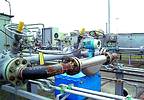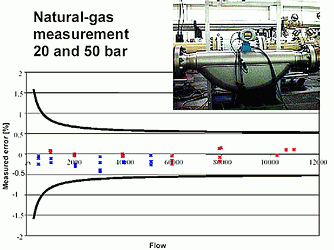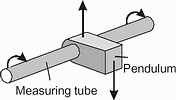
Since the introduction of the first Coriolis meters in the 1970s, a process of product improvement and development has evolved. Today, these multivariable meters are increasingly meeting the needs of industry, specifically the requirement to track more process variables. Endress+Hauser’s rolling development of its tried and tested PROline Promass range of Coriolis flowmeters has demonstrated how innovative implementations can satisfy the latest demands in the metering world.
In the process industry, Coriolis flowmeters are known as reliable and robust field instruments. Process dependability and efficiency have become increasingly vital, and the result is an increasingly wide field of application for these all-round versatile devices.
Today's flowmeters have to fulfil functions more diverse and more demanding than ever before. Meeting tight budgets, while optimising process efficiency and maintaining or improving product quality, are all putting pressure on flowmeters to meet growing measurement and control requirements.
There are many reasons why Coriolis mass flowmeters have become so successful in the process sector of the chemical industry over recent years. The flowmeters measure mass flow directly - and to a high degree of accuracy, thus supporting optimum process control and stable compliance with recipes in blending procedures - two key factors in enhancing product quality and improving process efficiency.
Gas metering
Coriolis meters can be used in a wide variety of other applications, besides measuring flows of process fluids. One application where Coriolis flowmeters can be effectively utilised is in gas metering, as here, too, measuring accuracy is crucial to keep costs down, as well as optimise process engineering. Ethylene is commonly used in the process industry. For example, DOW Chemicals meters ethylene gas at pressures ranging from 7,5 to 9,5 MPa (75 to 95 bar) and a medium temperature of 10°C. Gas flow has to be metered in the range of 10 to 40 metric tons per hour. The company originally used turbine meters to measure volume flow, so density also had to be measured before mass flow could be calculated. In addition, turbine meters are subject to strict limitations in terms of shutdown. These were some of the reasons why this operator opted to test the Promass F Coriolis flowmeter from Endress+Hauser, specifically for this application.
Like all members of the Promass range of sensors, Promass F has a high oscillation frequency (600 to 800 Hz) and is immune to pipeline vibrations between 50 and 200 Hz. Thus, vibrations in the pipeline system have no effect on the results obtained by the meter. (Figure 1). The design is robust and a standard secondary containment makes the device immune to external influences, such as shock loading and stresses in the pipeline.

Today, Promass F meters are being used in many gas applications. The meters have returned excellent results in tests by calibration institutes such as PIGSAR (Figure 2) and SWRI. Extensive testing conducted by DOW Chemical using an in-house calibration system, reconfirmed the high performance of Promass F meters. Besides high measuring accuracy, the operator was impressed by the long-term stability and significantly better turndown that the meters exhibited, in comparison to turbine meters.

Accuracy despite changes in pressure
Fast response times and high accuracy despite changes in pressure also make Promass F suitable for carbon dioxide applications in breweries and the plants that produce soft drinks. The pressure range for air metering extends from 300 kPa (beverage batching and filling) to 30 MPa (compressors for airbag gas generators). Typical applications include compressed natural gas and low-pressure gas - both are used as fuels for vehicles. Applications in low-pressure range from oxygen and chloride gas to hydrogen metering in the manufacture of semiconductors, as well as in the hydrogenation of fat, for example.
More than one variable with a single sensor
The ability to concentrate a number of process parameters into a single measuring point is one of the major strengths of Coriolis meters. Mass flow, density and temperature can all be measured by one single device. These measured variables can be combined, which means that a single process-metering device is all that is needed to calculate derivative variables, such as concentration in fluids - and no additional measuring points are necessary. In the wastewater industry, for example, plant operators have to analyse the concentration of the active sewage sludge.
Two factors are of prime importance when calculating concentration. Firstly, there is a requirement for highly accurate density measurement. In this respect, Promass F has the ability to measure density to a high degree of accuracy, not only under reference conditions or at defined process points, but also over the entire process range from 0,8 to 1,8 kg/l and from 5 to 80°C. Secondly, it is important to be aware of the relationship between concentration, density and temperature. The Promass integrates the standard formulas, such as volume % and Brix. However, this relationship often depends on the mediums blended in a given process and cannot be described by standardised formulas.
The operators of the ARA Olten sewage treatment plant in Olten, Switzerland needed to know the proportion of solid matter in the sludge fed to the digestion tower. This, in turn, can be used to calculate the efficiency of the gas-generation process. The relationship between solids proportion, density and temperature did not obey a standard formula. Promass 83 allowed the users to have these process-specific criteria mapped directly into the flowmeter, without any need for programming another processor or the process instrumentation and control system itself. The output generates precisely what the customer requires.
In-line viscosity measurement
Measuring silicone rubber containing particles of quartz requires highly accurate mass flowmetering - the entrained solids must not affect this accuracy. In this particular case, due to the high viscosity of the medium, only a very small pressure loss can be tolerated. The single straight tube meter, Promass I, from Endress+Hauser is well suited to this application. Hygienic design makes the meter easy to clean and inhibits the formation of solids deposits. In this particular application, space was at a premium, making the compact Promass I even more attractive - it dispenses with inlet and outlet piping. Additional mounts are not necessary, due to the unique balancing for the single-tube meter achieved by the torsion mode balancing (TMB) system. With the TMB system, a new single straight tube Coriolis mass flowmeter was realised, offering balance similar to that of a double tube meter.
Taking multivariable technology further
Manufacturing meters with optimum application stability is one thing, but Endress+Hauser also realises that manufacturers require more and more information about their processes. This is what prompted the Promass I's ability to measure viscosity - in addition to mass, density and temperature. Promass I is claimed to be the first Coriolis meter in the world with direct-in-line viscosity measurement. This meets the increasing requirements for multivariable measurement technology.

Viscosity (the ratio of shear stress to shear rate) is a crucial variable that can provide an indication about product and process changes. For example, non-Newtonian fluids, either, exhibit reduced or increased viscosity when the shear rate is high. For viscosity measurement, Promass I utilises the patented TMB system. (Figure 3) A pendulum mounted on the measuring tube causes a torsional movement, in addition to the lateral oscillation movement of the measuring tube. (Figure 4) These movements cause a velocity profile. Based on this profile, shear forces and corresponding shear rates develop in the fluid. As with rotational viscometers, these shear rates are related to the viscosity of the medium. The shear forces dampen the tube oscillation, resulting in a larger drive force being required in order to maintain the tube oscillation. Hence, the viscosity can be determined by measuring the required power (excitation current) for tube oscillation and torsional movement. It is important to realise that the shear rate in Promass differs from a laboratory viscometer, making comparison between the two measurement technologies complex.

Wide range of applications
Among the applications that have already been successfully used are filling of paints into tankers at loading stations; determination of the quality ratios in mixers for dispersions; determination of the density of lime milk (only a single tube can resist the high abrasion forces); measuring the fuel feed in oil burners (the single tube is also capable of measuring very dirty oils); and quantity determination in the rubber industry.
Process optimisation
The Promass I can be used as a sensor for four process variables at any one time, and the metering processes involved do not affect each other in any way. Plant operators receive in-depth information on all process variables available at any one time, which provides a complete overview of the process and allows ongoing optimisation of the process and improvement of the end product.
For more information contact Grant Joyce, Endress+Hauser, 011 262 8000, [email protected], www.za.endress.com
| Tel: | +27 11 262 8000 |
| Email: | [email protected] |
| www: | www.endress.com |
| Articles: | More information and articles about Endress+Hauser South Africa |

© Technews Publishing (Pty) Ltd | All Rights Reserved